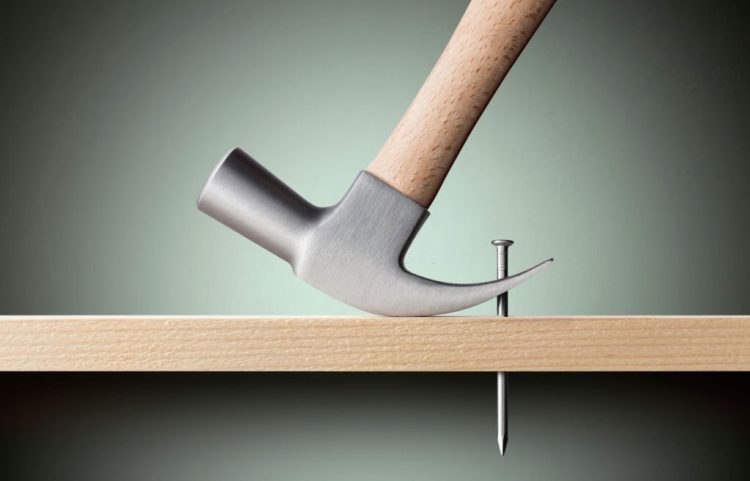Nails can be really frustrating when you are in the middle of any project. Hammering, drilling, driving, and nails usually do not mind any procedure that is adapted to instill them in any surface. However, a real problem arises when you try to take them out of anything, and that too without any hammer.
Let us take you to some of the most innovative yet handy ways to remove a nail out of any surface without a hammer. They will definitely help you get the job done without any damage to the nail and the material as well.
How to Remove Nails Without the Help of A Hammer
Here are some alternatives to try
1. Nail Pullers to Rescue
It is a well-noted fact that the right tool for the right job can reduce fatigue by up to 50% and thereby be experimented with to produce better results. So, without wasting any more of your time and energy on removing the nails with anything else, just grab your nail puller and quickly follow the following steps,
- Grab your nail puller and try to find the best possible angle
- It is really important to get the puller at the right angle because the rough angle might damage the wood or any other material.
- Once you have reached the head of a nail, determine the side (usually it is the opposite side) where you want to apply the pressure to bring the nail out.
- As soon as your nail fixes into the claw of a nail puller, it’s good and pretty to come out without any harsh treatment.
Pro Tip:
This job can be done by using almost all types of nail pullers, pry bars, claw ends, etc. So don’t worry if you don’t have a hammer. Grab any of these tools and it will be done with ease and perfection.
2. A Fork Can Do A Lot:
Probably one of the most primitive kinds of tools that can help you pull the nail without a hammer can be nothing other than a fork. Remember that it can only work on small and thin nails.
Also if the fork is of high quality (say steel) only then it can bring out the nail. Otherwise, it might damage the fork and may hurt you as well. All you need to do is to,
- Examine if the nail and the surface (say wall or wood etc.) has some distance.
- If yes, fix the prongs of a fork in such a way that it can firmly get fixed with the head of a nail.
- Once you get the prongs there, apply gradual pressure in the opposite direction.
- Make sure you do not go harsh or apply immense pressure because it can hurt your hand.
- Take out the nail by applying most pressure on a point where its prongs are firmly fixed.
- There you go; it will be out sooner than your expectations.
Downside:
Whether you try it on a wall or against some wood, using a fork to remove nails may result in extreme manual fatigue. As there is no considerable distance between the nail, your tool (fork), and the plane of action, it’s more like exerting pressure against the surface. You are liable to get strong pain for a short period of time.
3. Time to Take Out Chisel:
That’s a thing about hand tools; they can always do more than you think. Chisels are one of the great tools to remove nails from any surface.
The positive aspect of using a chisel is that, it does not mind how thick, sturdy, string or deeply embedded the nail is, it simply knows how to take it off.
So you don’t need to worry about any of these things and just can take the nail on the surface by taking the following steps.
- Grab the chisel and try to find the best possible side.
- It will help you get the nail out with the least surface damage.
- After this, establish a firm grip and push it up. The nail will come out without any problem.
Downside:
Do not use a chisel to take out thin and relatively low-quality nails. It can make a mess against thin nails by damaging their heads and sometimes totally flinging them. So it is highly suggested not to use a chisel for things and not so-strong nails.
4. Butter Knife:
Another simple hack to get the nail out is to use a butter knife against it. It may sound hilarious but you can use a fork and butter knife together as well. With the help of a butter knife, you can first make a space by prying the nail just at its point of contact with the surface.
After you have craved enough space, bring the fork into action and it will do the rest of the job. Using a butter knife can actually help you get the nail out that too without damage. Remember that it can be used against small and thin nails only.
5. Screwdriver Can Get You Out of a Screwed Situation:
A simple screwdriver can also help you remove the frustrating nails quite easily. All you need to do is to grab a flathead screwdriver and follow these steps,
- Keep your screwdriver against the head of the nail at holding it at 45 degrees.
- Once you are sure about the angle, establish a strong grip on the handle and apply pressure toward the tip.
- It will bring the nail out without any problem.
So, these were some of the methods that can be safely used to get nails out of any surface without a hammer. Please keep in mind that using a nail puller, pry bar, screwdriver, and chisel are comparatively more professional and relatively safer ways to take out a nail.
However, using a fork or a butter knife are simpler but not so safe ways to do so. They are handy and are used mostly by DIY enthusiasts to get the job done. Make sure to keep yourself and everyone around you safe and sound.

Meet Max, the founder and lead writer of our home improvement blog. He is a seasoned home renovation and design expert with over 8 years of experience in the industry.
Max has a passion for creating beautiful and functional living spaces and is dedicated to helping homeowners and DIY enthusiasts achieve their home improvement goals. He has worked on a wide range of projects, from small updates to full-scale renovations, and has a wealth of knowledge and experience to share.
As an avid DIYer, Max understands the challenges and rewards of tackling a home improvement project and enjoys sharing his tips, tricks and insights to make the process as easy and enjoyable as possible. In his free time, Max can be found working on his own home renovation projects, reading design blogs and magazines, and travelling to explore new design trends.
Max is excited to share his knowledge and experience with you and hopes to inspire and empower you to take on your next home improvement project with confidence. Follow Max on LinkedIn for more inspiration and expert advice.


